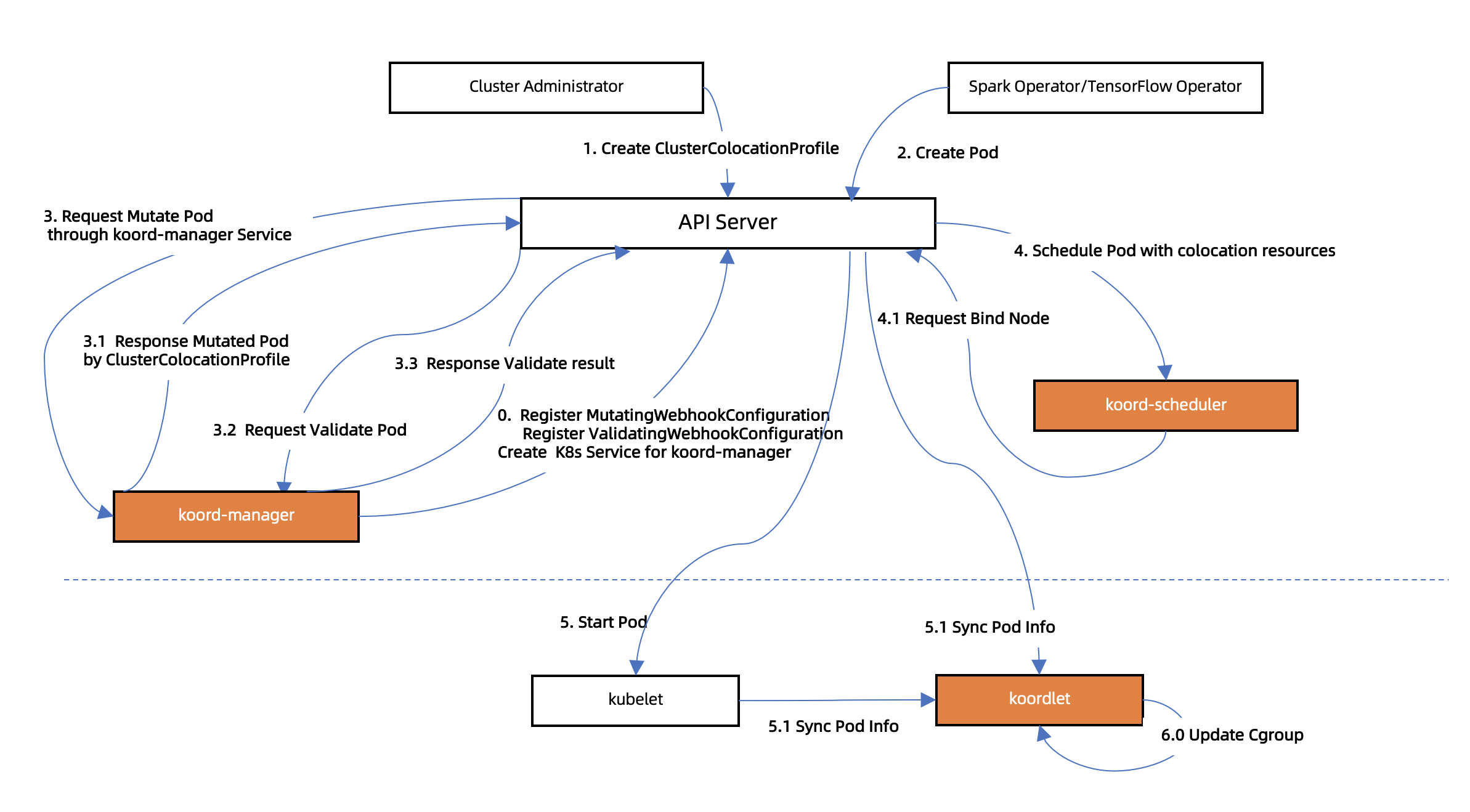Colocation Profile
Motivation
If the workloads in the existing cluster want to be co-located through Koordinator, you need to modify the existing Controller/Operator to support protocols such as the QoS class, priority, and resource model defined by Koordinator.
In order to avoid repeated construction and make it easier for everyone to obtain the benefits of co-location technology, Koordinator defines ClusterColocationProfile CRD, and implements webhook modify and verify newly created Pods, inject the fields described in ClusterColocationProfile.
Architecture

feature-gates
ClusterColocationProfile mutating/validating feature is turned on by default, if you want to turn it off set feature-gates:
$ helm install koordinator https://... --set featureGates="PodMutatingWebhook=false\,PodValidatingWebhook=false"
Spec definition
If you are not familiar with Kubernetes resources please refer to the page Understanding Kubernetes Objects.
namespaceSelector: decides whether to mutate/validate Pods if the namespace matches the selector. Default to the empty LabelSelector, which will match everything.
selector: decides whether to mutate/validate Pods if the Pod matches the selector. Default to the empty LabelSelector, which will match everything.
qosClass (required): describes the type of Koordinator QoS that the Pod is running. The value will be injected into Pod as label koordinator.sh/qosClass. Options are
LSE,LSR,LS,BE, andSYSTEM. For more information, please check here.priorityClassName (required): the priorityClassName and the priority value defined in PriorityClass will be injected into the Pod. Options are
koord-prod,koord-mid,koord-batch, andkoord-free. For more information, please check here.koordinatorPriority: defines the Pod sub-priority in Koordinator. The priority value will be injected into Pod as label koordinator.sh/priority. Various Koordinator components determine the priority of the Pod in the Koordinator through KoordinatorPriority and the priority value in PriorityClassName. Higher the value, higher the priority.
labels: describes the k/v pair that needs to inject into
Pod.Labels.annotations: describes the k/v pair that needs to inject into
Pod.Annotations.schedulerName: if specified, the pod will be dispatched by specified scheduler.
patch: indicates Pod Template patching that user would like to inject into the Pod.
Example
Create ClusterColocationProfile
The profile.yaml file below describes to modify Pod in Namepspace with label koordinator.sh/enable-colocation=true and inject Koordinator QoS, Koordinator Priority etc.
apiVersion: config.koordinator.sh/v1alpha1
kind: ClusterColocationProfile
metadata:
name: colocation-profile-example
spec:
namespaceSelector:
matchLabels:
koordinator.sh/enable-colocation: "true"
selector:
matchLabels:
koordinator.sh/enable-colocation: "true"
qosClass: BE
priorityClassName: koord-batch
koordinatorPriority: 1000
schedulerName: koord-scheduler
labels:
koordinator.sh/mutated: "true"
annotations:
koordinator.sh/intercepted: "true"
patch:
spec:
terminationGracePeriodSeconds: 30
Create a ClusterColocationProfile based on the YAML file:
$ kubectl apply -f profile.yaml
Verify ClusterColocationProfile works
apiVersion: v1
kind: Pod
metadata:
labels:
koordinator.sh/enable-colocation: "true"
name: test-pod
spec:
containers:
- name: app
image: nginx:1.15.1
resources:
limits:
cpu: "1"
memory: "3456Mi"
requests:
cpu: "1"
memory: "3456Mi"
Create this pod and now you will find it's injected with Koordinator QoS, Koordinator Priority etc.
$ kubectl get pod test-pod -o yaml
apiVersion: v1
kind: Pod
metadata:
annotations:
koordinator.sh/intercepted: true
labels:
koordinator.sh/qosClass: BE
koordinator.sh/priority: 1000
koordinator.sh/mutated: true
...
spec:
terminationGracePeriodSeconds: 30
priority: 5000
priorityClassName: koord-batch
schedulerName: koord-scheduler
containers:
- name: app
image: nginx:1.15.1
resources:
limits:
kubernetes.io/batch-cpu: "1000"
kubernetes.io/batch-memory: 3456Mi
requests:
kubernetes.io/batch-cpu: "1000"
kubernetes.io/batch-memory: 3456Mi